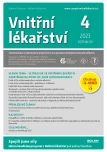Point‑of‑Care Ultrasound in internal medicine
Authors:
Zdeněk Monhart
Authors‘ workplace:
Lékařská fakulta Masarykovy Univerzity, Brno
; Interní oddělení a urgentní příjem, Nemocnice Znojmo
Published in:
Vnitř Lék 2023; 69(4): 214-221
Category:
Main Topic
doi:
https://doi.org/10.36290/vnl.2023.041
Overview
Point-of-Care ultrasound (POCUS) is bedside ultrasound examination performed by a clinician. POCUS is a suitable tool for rapid diagnosis and monitoring of the condition of many patients examined by internists in emergency departments and inpatient departments. POCUS allows the examining physician to supplement the physical examination with additional information obtained in real time, and is a useful tool for differential diagnosis of a number of acute conditions (shock, shortness of breath, etc.). Chest POCUS includes an indicative assessment of cardiac function and evaluation of the lung parenchyma, including exclusion of pericardial effusion, pneumothorax or fluidothorax. One of the most common applications of POCUS is to assess the state of the venous filling by examining the inferior vena cava. When examining the abdomen, the internist should at least be able to diagnose fluid in the abdominal cavity and exclude congestion in the hollow system of the kidney. POCUS for internists also includes examination of main venous trunks to rule out proximal venous thrombosis. Even when performing conventional invasive procedures, we cannot do without ultrasound at the bedside, whether it is a puncture of ascites or pleural effusion, or cannulation of the central vein. The advantage of POCUS is the immediate availability of the examination and the possibility to repeat scans when needed for monitoring the patient‘s condition.
Keywords:
Point-of-Care ultrasound – internal medicine – cardiac ultrasound – lung ultrasound – abdominal ultrasound
Sources
1. Weile J, Brix J, Moellekaer AB. Is point‑of‑care ultrasound disruptive innovation? Formulating why POCUS is different from conventional comprehensive ultrasound. Crit Ultrasound J. 2018 Oct 1;10(1):25.
2. Chiu L, Jairam MP, Chow R, et al. Meta‑Analysis of Point‑of‑Care Lung Ultrasonography Versus Chest Radiography in Adults With Symptoms of Acute Decompensated Heart Failure. Am J Cardiol. 2022 Jul 1;174:89-95.
3. Staub LJ, Mazzali Biscaro RR, Kaszubowski E, et al. Lung Ultrasound for the Emergency Diagnosis of Pneumonia, Acute Heart Failure, and Exacerbations of Chronic Obstructive Pulmonary Disease/Asthma in Adults: A Systematic Review and Meta‑analysis. J Emerg Med. 2019 Jan;56(1):53-69.
4. Eibenberger KL, Dock WI, Ammann ME, et al. Quantification of pleural effusions: sonography versus radiography. Radiology. 1994 Jun;191(3):681-4.
5. Alrajab S, Youssef AM, Akkus NI, et al. Pleural ultrasonography versus chest radiography for the diagnosis of pneumothorax: review of the literature and meta‑analysis. Crit Care. 2013 Sep 23;17(5):R208.
6. McKaigney CJ, Krantz MJ, La Rocque CL, et al. E‑point septal separation: a bedside tool for emergency physician assessment of left ventricular ejection fraction. Am J Emerg Med. 2014 Jun;32(6):493-7.
7. Weekes AJ, Thacker G, Troha D, et al. Diagnostic Accuracy of Right Ventricular Dysfunction Markers in Normotensive Emergency Department Patients With Acute Pulmonary Embolism. Ann Emerg Med. 2016 Sep;68(3):277-91.
8. Daley JI, Dwyer KH, Grunwald Z, Shaw DL, et al. Increased Sensitivity of Focused Cardiac Ultrasound for Pulmonary Embolism in Emergency Department Patients With Abnormal Vital Signs. Acad Emerg Med. 2019 Nov;26(11):1211-1220.
9. Ciozda W, Kedan I, Kehl DW, et al. The efficacy of sonographic measurement of inferior vena cava diameter as an estimate of central venous pressure. Cardiovasc Ultrasound. 2016 Aug 20;14(1):33.
10. Wong C, Teitge B, Ross M, Young P, et al. The Accuracy and Prognostic Value of Point‑of‑care Ultrasound for Nephrolithiasis in the Emergency Department: A Systematic Review and Meta‑analysis. Acad Emerg Med. 2018 Jun;25(6):684-698.
11. Torres‑Macho J, Aro T, Bruckner I, et al; EFIM’s ultrasound working group. Point‑of‑care ultrasound in internal medicine: A position paper by the ultrasound working group of the European federation of internal medicine. Eur J Intern Med. 2020 Mar;73:67-71.
12. Falster C, Jacobsen N, Coman KE, et al. Diagnostic accuracy of focused deep venous, lung, cardiac and multiorgan ultrasound in suspected pulmonary embolism: a systematic review and meta‑analysis. Thorax. 2022 Jul;77(7):679-689.
13. Mercaldi CJ, Lanes SF. Ultrasound guidance decreases complications and improves the cost of care among patients undergoing thoracentesis and paracentesis. Chest. 2013 Feb 1;143(2):532-538.
14. Franco‑Sadud R, Schnobrich D, et al; SHM Point‑of‑care Ultrasound Task Force; Soni NJ. Recommendations on the Use of Ultrasound Guidance for Central and Peripheral Vascular Access in Adults: A Position Statement of the Society of Hospital Medicine. J Hosp Med. 2019 Sep;14(9):E1-E22.
15. Wilson SP, Assaf S, Lahham S, Subeh M, Chiem A, Anderson C, Shwe S, Nguyen R, Fox JC. Simplified point‑of‑care ultrasound protocol to confirm central venous catheter placement: A prospective study. World J Emerg Med. 2017;8(1):25-28.
16. Lichtenstein DA, Mezière GA. Relevance of lung ultrasound in the diagnosis of acute respiratory failure: the BLUE protocol. Chest. 2008 Jul;134(1):117-25.
17. Zanobetti M, Scorpiniti M, Gigli C, et al. Point‑of‑Care Ultrasonography for Evaluation of Acute Dyspnea in the ED. Chest. 2017 Jun;151(6):1295-1301.Lichtenstein DA. BLUE‑protocol and FALLS‑protocol: two applications of lung ultrasound in the critically ill. Chest. 2015 Jun;147(6):1659-1670.
Labels
Diabetology Endocrinology Internal medicineArticle was published in
Internal Medicine

2023 Issue 4
Most read in this issue
- Osteomalacia
- Point‑of‑Care Ultrasound in internal medicine
- In the prevention of dementia, the focus should be on early and consistent treatment of hypertension
- Deep vein thrombosis – the role of ultrasound in the diagnosis and follow-up of patients
